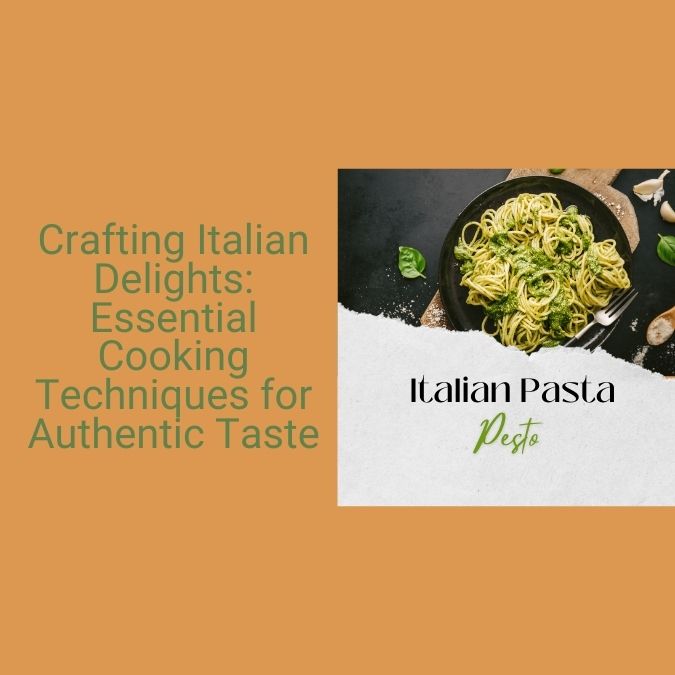Italian cuisine is renowned around the globe for its mouth-watering and diverse flavors. From the simplicity of a traditional Margherita pizza to the intricacy of a slow-simmered Bolognese sauce, there’s something indeed magical about the way Italians prep their plates. At the heart of this culinary art lies a set of fundamental Italian cooking techniques that foster every single dish to a level of authentic and memorable taste. Look at these techniques, step by step, to help you bring the true spirit of Italy into your kitchen.
The Foundation: Fresh Ingredients
The headstone of Italian cooking is undoubtedly the usage of fresh, high-quality stuff. Italians are passionate about sourcing the most suitable produce, and it’s an essential phase in attaining that authentic taste. Folks have an innate appreciation for the intrinsic flavors of their produce, and this reverence is palpable in their dishes. Whether it’s the rich red of ripe tomatoes, the aroma of fresh basil, or the robustness of extra-virgin olive oil, the core of each ingredient is permitted to shine. This dedication to sourcing the best stuff makes a harmonious union of flavors in Italian cuisine, resulting in dishes that are simple yet profoundly appetizing. For authentic Italian taste, begin with impeccable ingredients—it’s a principle that Italians carry dear and one that every striving Italian chef should welcome.
The Art of Simplicity
One of the hallmarks of Italian cooking is its simplicity. Those dishes often feature a few key elements that are allowed to glow. The key here is to let each component speak for itself. For instance, a Caprese salad with fresh mozzarella, tomatoes, basil, as well as olive oil is a premium example of how minimalism can direct to maximum flavor.
Embrace Homemade Pasta
While store-bought pasta is suitable, making your pasta from scratch can be a game-changer. Homemade pasta has a different texture and taste that store-bought varieties simply can’t match. Learning the art of pasta making, whether it’s tagliatelle or gnocchi, will unlock a world of authentic Italian dishes.
Perfecting Risotto
Risotto is a dish that needs tolerance and attention to detail. The slow addition of hot broth, endless stirring, and the usage of Arborio rice are all key factors in achieving that creamy, luscious texture that makes risotto an Italian classic. Once you’ve grasped this technique, you can cook countless variations with various ingredients like mushrooms, saffron, or seafood.
Balancing Flavors with Sauces
Italian cuisine boasts a comprehensive range of sauces, each with its uncommon traits. Whether it’s a classic marinara, a creamy and hearty ragù, or a luscious Alfredo sauce, mastering the art of sauce-making is vital for authentic Italian flavors. Keep a close eye on the balance of acidity, sweetness, as well as richness in every single sauce.
Herbs and Aromatics
Fresh herbs like basil, oregano, rosemary, and thyme play a critical role in Italian cuisine. The way you address these spices can significantly impact the final flavor of your plate. Learn when to add them (fresh or dried), how to chop them finely, and how to remove their oils for the ultimate smell.
The Magic of Olive Oil
Olive oil is the cornerstone of Italian cooking, and knowing its different types and how to utilize them is necessary. Extra-virgin olive oil is best for drizzling over finished dishes, while a lighter olive oil is appropriate for sauteing. Learn to appreciate the nuances of various olive oils to foster the authenticity of your Italian bowls.
The Art of Cheese
Italy is well-known for its cheese, and there’s a cheese for nearly every Italian dish. Mozzarella for pizzas, Parmesan for pasta, and Gorgonzola for risottos – each cheese has its bespoke role in Italian cuisine. Comprehending when and how to use these cheeses can elevate your dishes to a new status of deliciousness.
Mastering the Pizza Oven
Pizza is an iconic Italian dish, and nothing beats the taste of a pizza cooked in a wood-fired oven. While individuals may not have a pizza oven at the house, knowing how to imitate that crispy, charred crust and bubbling cheese in a time-honored oven or on a grill is a skill worth acquiring.
Perfecting the Art of Al Dente
The term “al dente” describes pasta that’s boiled to be firm to the bite. Achieving this texture is essential in Italian cooking. To master the art of al dente pasta, pay attention to cooking times, test for doneness, and never overcook your noodles.
So finally, Italian cooking is all about the celebration of reenergized, flavorful ingredients and the mastery of essential techniques. By integrating these strategies into your culinary repertoire, you can recreate the authentic bowls of Italy in your cooking space. Remember, practice makes perfect, so don’t be scared to experiment and make these techniques your own.

